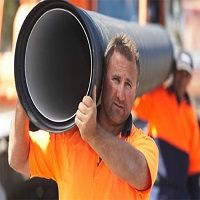Comprehensive study highlights PVC pipe's century-long reliability
 LOGAN, UT, May 16, 2014 -- A comprehensive study on PVC pipe excavations, testing and lifecycle analysis has been published by the Utah State University (USU) Buried Structures Laboratory. USU, located in Logan, Utah, is also home to the Utah Water Research Laboratory and has significantly contributed to water and wastewater research internationally for over 50 years.
LOGAN, UT, May 16, 2014 -- A comprehensive study on PVC pipe excavations, testing and lifecycle analysis has been published by the Utah State University (USU) Buried Structures Laboratory. USU, located in Logan, Utah, is also home to the Utah Water Research Laboratory and has significantly contributed to water and wastewater research internationally for over 50 years.
waterworld: The study reviews past dig-up reports and presents new quality control testing results that continue to validate the performance and longevity of PVC pipe used in water networks. A combination of pipe examination and testing data in conjunction with previous pipe break studies support PVC as a sustainable pipe material and confirm its longevity in excess of 100 years.
"Understanding the longevity of pipes improves the ability of a water utility to make better infrastructure investment decisions with improved affordability results for customers," said report author Dr. Steven Folkman.
A previous USU study on water main breaks in the U.S. and Canada showed PVC pipe to have the lowest rate of main breaks of all pipe materials examined, which included ductile iron, cast iron, steel, concrete, and asbestos cement. This report continues to explore PVC reliability and longevity. Additionally, the critical issue of affordability is examined, which could not come at a better time as the U.S. water sector faces the difficult task of renewing its buried infrastructure.
"This study provides the next body of evidence supporting the ability of utilities to address the failing infrastructure and the affordability dilemma," said Folkman. According to the U.S. Conference of Mayors, a total of $2.28 trillion is needed in water and wastewater piping over the next 20 years.
A major finding of the study is that U.S. water utilities can reduce water main breaks and operations and maintenance costs by including corrosion-proof PVC piping in their replacement programs. Earlier research by USU showed that corrosion of iron piping is a major problem for water systems, and newer metallic pipes are experiencing failures more rapidly than older types because of their thinner walls.
The report also found that PVC pipes offer a high degree of resilience in freezing conditions. This would help reduce the ever increasing number of iron pipes that fail during winter across the U.S. annually.
"Many utilities have fallen short in producing appropriate cost and lifecycle comparisons of pipe performance. Data on water pipe longevity must be combined with asset management techniques to make water and sewer infrastructure more durable and affordable. Further, elected officials, financial managers and utility professionals must work together to create a new management paradigm for water and wastewater systems," said Folkman.
This study contributes to the continuing efforts of the EPA's Aging Water Infrastructure (AWI) research and work by the American Water Works Association (AWWA) and the American Society of Civil Engineers (ASCE).
.gif)
.gif)

Comments